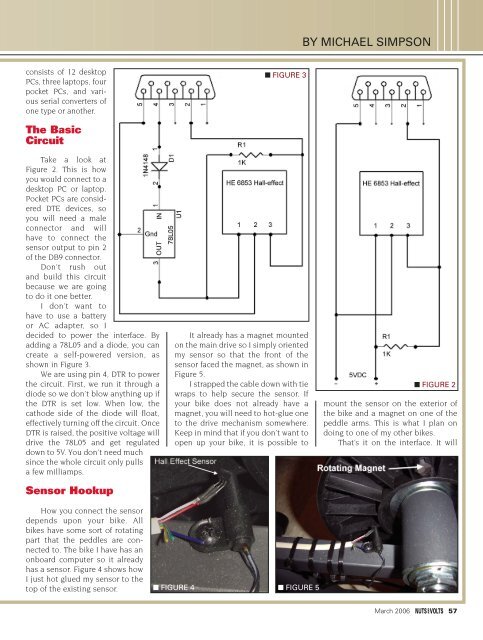Nuts & Volts
Nuts & Volts
Nuts & Volts
You also want an ePaper? Increase the reach of your titles
YUMPU automatically turns print PDFs into web optimized ePapers that Google loves.
BY MICHAEL SIMPSON<br />
consists of 12 desktop<br />
PCs, three laptops, four<br />
pocket PCs, and various<br />
serial converters of<br />
one type or another.<br />
■ FIGURE 3<br />
The Basic<br />
Circuit<br />
Take a look at<br />
Figure 2. This is how<br />
you would connect to a<br />
desktop PC or laptop.<br />
Pocket PCs are considered<br />
DTE devices, so<br />
you will need a male<br />
connector and will<br />
have to connect the<br />
sensor output to pin 2<br />
of the DB9 connector.<br />
Don’t rush out<br />
and build this circuit<br />
because we are going<br />
to do it one better.<br />
I don’t want to<br />
have to use a battery<br />
or AC adapter, so I<br />
decided to power the interface. By<br />
adding a 78L05 and a diode, you can<br />
create a self-powered version, as<br />
shown in Figure 3.<br />
We are using pin 4, DTR to power<br />
the circuit. First, we run it through a<br />
diode so we don’t blow anything up if<br />
the DTR is set low. When low, the<br />
cathode side of the diode will float,<br />
effectively turning off the circuit. Once<br />
DTR is raised, the positive voltage will<br />
drive the 78L05 and get regulated<br />
down to 5V. You don’t need much<br />
since the whole circuit only pulls<br />
a few milliamps.<br />
Sensor Hookup<br />
It already has a magnet mounted<br />
on the main drive so I simply oriented<br />
my sensor so that the front of the<br />
sensor faced the magnet, as shown in<br />
Figure 5.<br />
I strapped the cable down with tie<br />
wraps to help secure the sensor. If<br />
your bike does not already have a<br />
magnet, you will need to hot-glue one<br />
to the drive mechanism somewhere.<br />
Keep in mind that if you don’t want to<br />
open up your bike, it is possible to<br />
■ FIGURE 2<br />
mount the sensor on the exterior of<br />
the bike and a magnet on one of the<br />
peddle arms. This is what I plan on<br />
doing to one of my other bikes.<br />
That’s it on the interface. It will<br />
How you connect the sensor<br />
depends upon your bike. All<br />
bikes have some sort of rotating<br />
part that the peddles are connected<br />
to. The bike I have has an<br />
onboard computer so it already<br />
has a sensor. Figure 4 shows how<br />
I just hot glued my sensor to the<br />
top of the existing sensor.<br />
■ FIGURE 4<br />
■ FIGURE 5<br />
March 2006 57

















